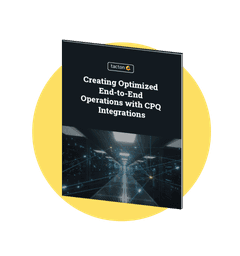What is Sales and Order Fulfillment process?
In the first post in our series on Tacton CPQ integrations, we explored the ways Tacton CPQ Administration received master data from other enterprise systems in the New Product Development process. In this article we describe how the front-office sales tools of Tacton CPQ – sometimes referred to as connected environments – reap the fruits from that work in the Sales & Order Fulfillment process.
The sales & Order Fulfillment process is one of the most important business processes of any successful company, where prospects are found, converted to customers and then delivered products/services/value. The journey of the customer typically includes handovers between marketing, sales and order fulfillment organizations (factory, supply chain, installation). For complex industrial equipment, this journey can be long and difficult – both for the customer and the vendor – including pushbacks, hundreds of decision points and questions, repricing, rescheduling deliveries, rescoping, order errors, reworks and misunderstandings.
CPQ integrations in the front-office sales tools
By replacing a manual Engineer-to-Order workflow (ETO) with Configure to-Order (CTO), a modern CPQ makes that journey less bumpy. With the right product and pricing data from your ERP, PLM, Price Management and PIM, the CPQ used by your sales teams and resellers, will generate fast a flawless quotes and orders. But there are also other systems in that front-office sales flow which a CPQ needs to be aligned with.
Customer relationship Management systems (CRM)
Most likely you keep track of your customer lifecycle in a CRM, including purchases, service and renewals. In CRM you identify sales opportunities, capture customer needs, define the products/line items to be sold, send out quotes and ensure that customers sign the contract. If you are selling simple standard products with a small assortment, most likely a CRM is all you need. For highly configurable products, however, a CPQ solution is necessary in order to map customer needs with technical solution, give a correct price and generate compelling and accurate quote documents.
This means that the CRM and the CPQ need to be interlinked: The CRM typically feeds the CPQ with accounts and opportunities (mastered in CRM), including basic information about the customer. CPQ would then use this data to drive the configuration – in addition to all other customer needs that the sales rep would enter when configuring. After the CPQ has generated technical solutions (quote line items), prices and quotes, those are then fed back to the CRM so that sales rep can continue and close the deal there. In this way, the CRM is always updated with the latest quote revisions and opportunity sizes, contributing to an accurate sales pipeline and forecasting.
Some CRMs also offer support for managing and automating the business processes and relationships between companies and their channel partners – often called Partner Relationship Management systems (PRM). If you are using a PRM to support and track your resellers’ sales transactions, a similar kind of integration with CPQ needs to be set up so that your resellers also can configure, price and quote in the same vein as your direct sales. As product eligibility and price models often differ across direct sales and partner sales, it is important that the CPQ can support that. Tacton CPQ offers standardized integrations with Salesforce and Microsoft Dynamics 365 CRMs but with flexible and open APIs it is possible to send transactional data to and from any CRM.
eCommerce
There is also another sales channel emerging in the B2B manufacturing space: eCommerce and self-service have so far been restricted to after sales and simpler products in the assortment (if used at all), but with easy-to-use CPQ tools, needs-based configurations, instant pricing and product visualization, even non-technical customers can configure error-free industrial machinery on their own. Empowering your customers with product configuration tools, means lower sales costs and better accessibility for your customers, fulfilling your multi-channel and omnichannel vision.
Just as with partner sales, self-service channels most likely have different configuration capabilities and price waterfall compared to that of a direct sales CPQ, but all channels need to be fed the same product definition from the CPQ to avoid excessive maintenance costs. Any modern CPQ needs to be capable of exposing their configuration, pricing and quoting capabilities to homegrown or standard eCommerce platforms.
Tacton CPQ’s API for Lead Generation allows anonymous (pre-lead) users to configure and visualize a product. With this embedded on a website, a manufacturer can empower prospects to explore the full portfolio before they reach out to your sales department. This could influence the way they formulate their buying criteria and RFXs – to your advantage.
With Tacton CPQ’s API for Self Service you enable both configuration, pricing and quoting for a known customer, allowing them to take full ownership of the whole buying journey, all the way up to check-out and ordering. This can be embedded into any eCommerce system.
Computer-Aided Design (CAD)
CAD design files and drawings are important documents in the buying process, aligning expectations between buyer and seller of complex industrial equipment. The cost of manually generating them by sales engineers, however, is high, especially considering that the buying journey may include hundreds of revisions.
Modern CPQ systems offer connections with CAD so that the values and technical solution specified in CPQ automatically can generate design files and drawings for the customer, without any need for sales engineering involvement. Tacton CPQ’s CAD Automation allows sales reps to generate advanced CAD files directly in the web browser with neither CAD skills or CAD software required. For all the millions of valid product variants and customizations that the product definition in CPQ can generate.
External calculations and simulations
In many industries, different kinds of simulations are required as a part of the quote documentation. If you are selling pumps, valves, heat exchangers, ventilation systems or cooling systems, for example, flow simulation software are often used to simulate and calculate how liquids and gas move inside the equipment. In these cases, the CPQ needs to send the tech specs and customer needs of a configured product to the external simulation system, which then calculates and returns the results to CPQ. CPQ can then use this to populate other values in the configuration or embed them into the quote document.
In Tacton CPQ this is refereed to as External Calculations, and are available through standard integration endpoints.
Enterprise Resource Planning system (ERP)
One of the most important benefits of a CPQ is the way it automates the order management process, increasing order speed and accuracy. Since CPQ provides the “handshake” between customer needs and order fulfilment, your factory and supply chain know how to produce, assemble and install an incoming order from the CPQ (as set up in the New Product Development process). This minimizes order errors and ensures that the promised functionality (and value) of the equipment can be delivered, within budget and timeframe.
The CPQ-ERP integration needs to encompass the capability of sending hierarchical BOM-structures which the ERP can receive and then translate into manufacturing BOMs and routings.
One important function of an ERP is to forecast and plan production. With long sales cycles and hundreds of deal revisions, it is important that the ERP gets accurate information early. Here CPQ can help: even long before the order has been placed, the CPQ-ERP integration can continuously feed the ERP with estimated order contents so that ERP can prepare inventories and logistics accordingly. This will make the order fulfillment journey fast and flawless, boosting your customer satisfaction as well as your bottom line.
This tight pre-order connection between CPQ and ERP could also go the other way. After receiving the order materials for an ongoing quote from CPQ, the ERP can calculate estimated delivery time, often called Available-to-promise (ATP). For customized products, such calculations can be quite advanced taking into considerations stock levels, order pipe, shipping disruptions, supplier capacity, historical lead time etc. Once received by the CPQ, the ATP can be embedded automatically into the quote and then communicated to the customer.
In the post-order phase, order status and updated delivery times can automatically be fed back to CPQ (and to the CRM), so that sales rep and customer can track the order without having to login into ERP or ask order handlers for that information.
Interested in learning more? Schedule your personalized demo today!
This piece was written by Tacton’s Senior Product Marketing Manager Per Rohdin



